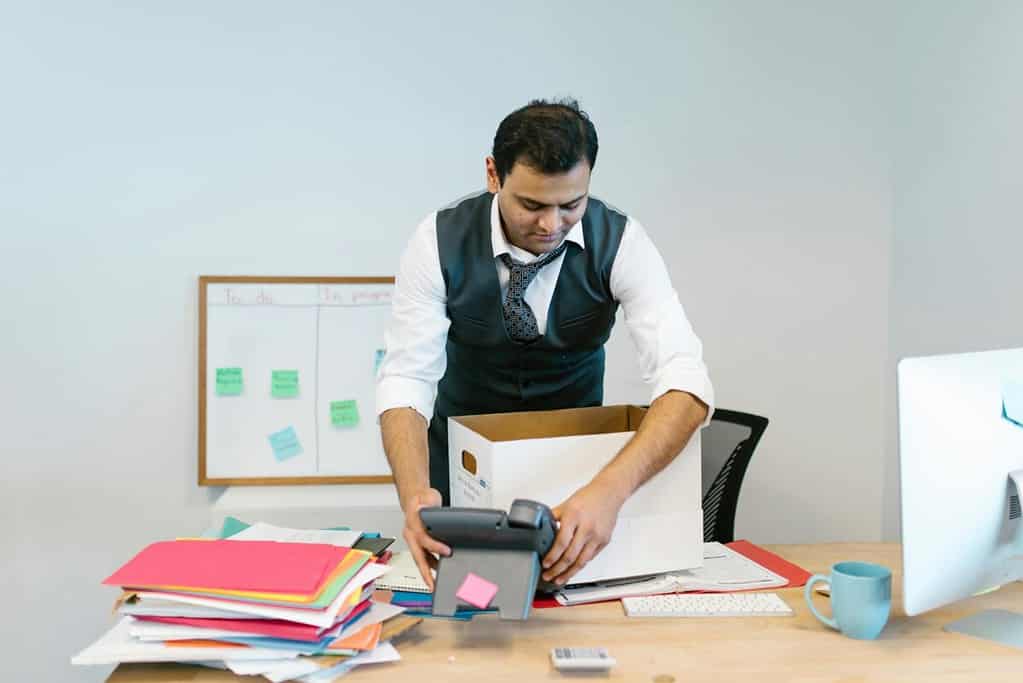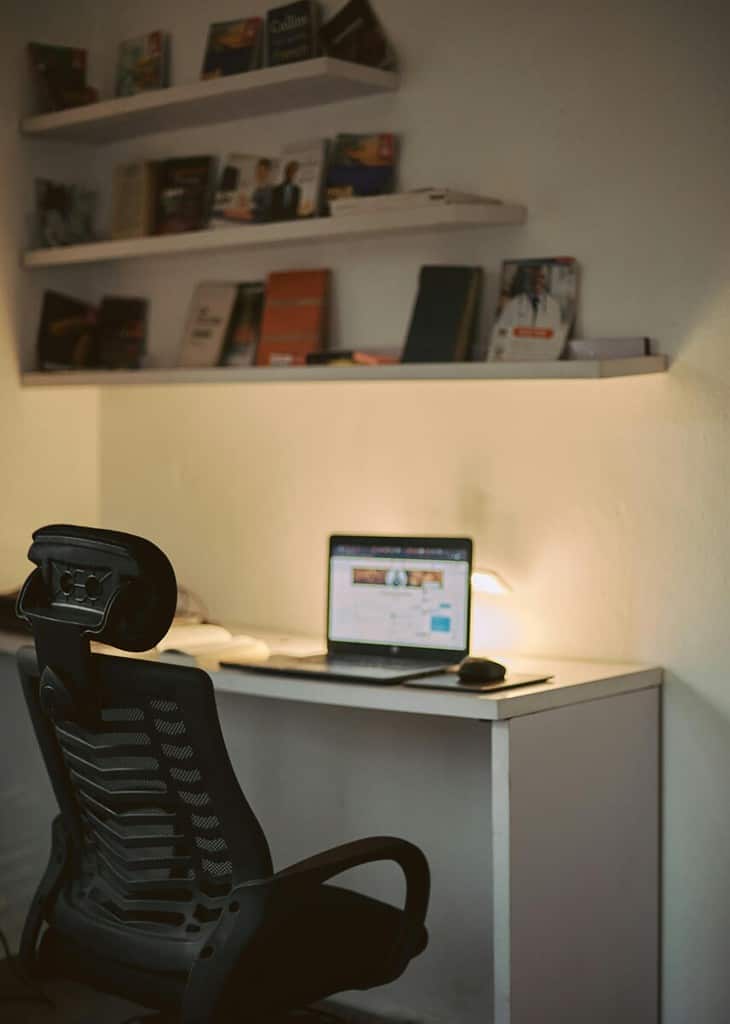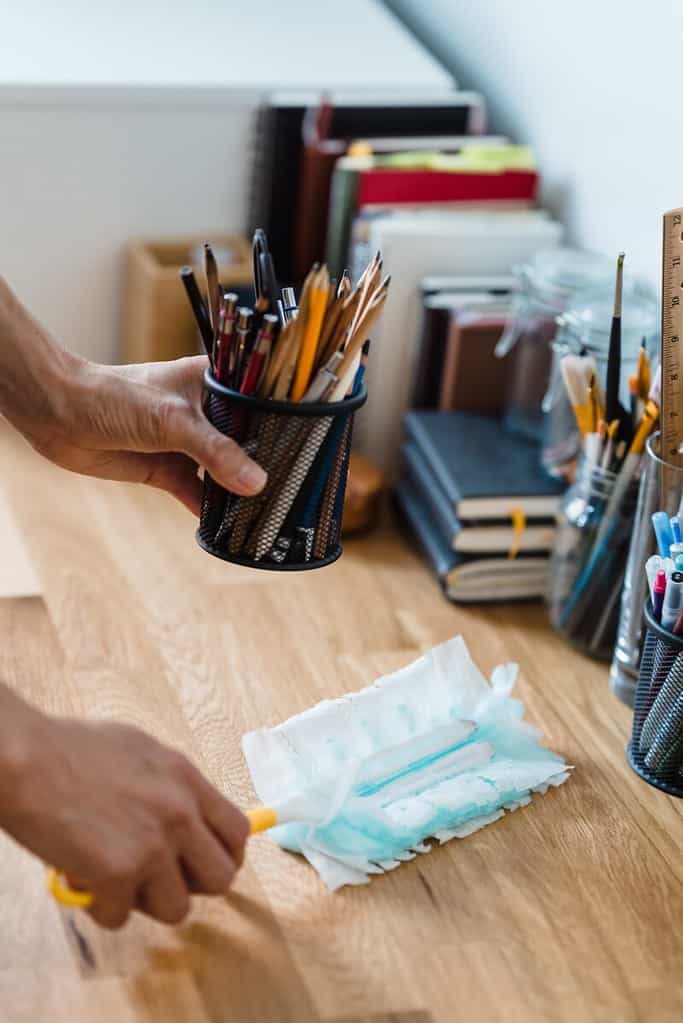How can I make my home office productive? This is a question many professionals grapple with in the age of remote work. Understanding the key steps to achieve this transformation is crucial. Let’s explore these fundamental strategies that can turn any chaotic space into a haven of productivity.
As a general rule, there are three key steps: effective decluttering, ergonomic design, and personalized organization. These steps transform your home office from chaos to peak productivity to elevate your space for the workday.
Ready for more than just a tidy desk? Next, we’ll explore innovative organizing hacks, ergonomic tools that promise comfort and efficiency, and custom routines that successful professionals swear by. Discover how your home office can become a hub of inspiration and productivity.

Decluttering: Laying the Foundation for an Efficient Workspace
How do you organize your home office for maximum productivity? It all begins with decluttering. A clutter-free workspace doesn’t just look better—it allows your mind to focus and your creativity to flow. We’ll guide you through a proven decluttering process to keep what’s essential and clear out the rest. From the paper piles to the digital mess, we’ll show you how to create a system that keeps your workspace organized and your mind clear. Say goodbye to the time wasted searching for lost items and hello to a streamlined process that sets the stage for your most productive work.
The Decluttering Mindset
Begin your decluttering journey with the right mindset. Understand that decluttering isn’t just about removing things; it’s about creating a space that fosters focus and productivity. Start by visualizing how you want your workspace to look and feel. This vision will guide your decluttering decisions and keep you motivated.
Step-by-Step Decluttering
First, tackle one area at a time to avoid feeling overwhelmed. Start with your desk, then move to shelves, drawers, and digital clutter. Applying each area’s ‘keep, discard, or relocate’ principle. Keep what you need at arm’s reach, discard what no longer serves a purpose, and find a new place for items that belong elsewhere.
Organizing What Remains
After decluttering, organize the remaining items. Use drawer dividers, document holders, and digital organizing tools to keep everything in its place. Label everything clearly and designate specific spots for frequently used items. This system will keep your space tidy and save you time locating what you need.
Maintaining Decluttered Spaces
Decluttering is not a one-time task; it’s an ongoing process. Incorporate a short daily routine to tidy up your workspace at the end of each day. This habit will prevent clutter from building up and ensure that your workspace remains a sanctuary of productivity.

Ergonomics: Crafting a Comfortable and Efficient Workspace
Once you have decluttered your space, the next step is to ensure its ergonomically optimized. Ergonomics in your home office is more than comfort; it’s about creating a space that enhances productivity and minimizes strain or injury over long periods. Here’s how to achieve an ergonomic setup that works for you.
Understanding Ergonomics
Ergonomics is the science of designing the workspace to fit the user’s needs. It aims to improve posture, reduce strain, and increase efficiency. Start by assessing your current setup: Is your chair at the right height? Is your screen at eye level? Minor adjustments can lead to significant improvements in comfort and concentration.
Essential Ergonomic Adjustments
Adjust your chair so your feet rest flat on the ground, with your knees at a 90-degree angle. Your computer monitor should be at eye level to prevent neck strain. Invest in a quality chair that offers good lumbar support. Consider a standing desk or a desk converter to alternate between sitting and standing throughout the day.
Personalizing Your Setup
No two bodies are the same, and neither are their ergonomic needs. Experiment with different setups to find what feels most comfortable for you. Pay attention to any signs of discomfort or strain, as these are indicators that something in your setup needs adjustment. Personalizing your space also means considering lighting, room temperature, and noise levels to create an environment conducive to focused work.
The Role of Breaks and Movement
Ergonomics isn’t just about equipment; it’s also about behavior. Regular breaks and movement are crucial. Integrate short breaks every hour to stretch, walk, or rest your eyes. This practice prevents physical strain and boosts mental clarity and productivity.

Storage Solutions: Maximizing Space and Efficiency
How do you organize productivity? It starts with how you organize your space, particularly your storage. Practical storage solutions are a cornerstone of productivity in a home office. They keep your essentials within reach, save time, and reduce distractions. Let’s explore how smart storage can be a game-changer for your productivity.
Identifying Storage Needs
Start by identifying what needs to be stored and how often you use these items. Categorize items into frequently used, occasionally used, and rarely used. This categorization will help you decide where to store them for easy access. Remember, the goal is to keep your workspace clear and everything within reach when needed.
Utilizing Vertical Space
Vertical space is often underutilized in home offices. Consider installing shelves above your desk for books, binders, and less frequently used items. Wall-mounted organizers can hold stationery, and floating shelves can display decorative items or plants, adding a touch of personality to your workspace.
Smart Use of Desk Organizers
Desk organizers are invaluable for keeping your workspace clutter-free. Use drawer dividers for small items like pens and clips. If your desk lacks drawers, invest in desktop organizers or storage trays. The key is having a designated place for everything so your desk remains orderly and functional.
Creative Storage Solutions
Don’t be afraid to get creative with storage. Use baskets, decorative boxes, or DIY solutions to add a personal touch to your storage system. Use these to store cables, chargers, and other tech accessories, keeping them out of sight but within easy reach.

Aesthetic and Atmosphere: Designing an Inspiring Workspace
Your home office should be more than just functional—it should also be a space that inspires and motivates you. The right aesthetic and atmosphere can significantly influence your mood and productivity. Let’s explore how to create a workspace that meets your practical needs, reflects your style, and promotes positivity.
The Power of Aesthetics
Never underestimate the impact of a visually appealing workspace. Choose a color scheme that resonates with you – colors can profoundly affect your mood and energy levels. Incorporate elements that spark joy, whether artwork, photos, inspirational quotes, or plants. A personalized space can make your workday more enjoyable and inspiring.
Lighting and Comfort
Good lighting is crucial. Natural light is best, so set up your workspace near a window if possible. If not, ensure you have ample artificial lighting that’s bright enough to prevent eye strain but soft enough to create a warm, inviting atmosphere. Comfort is also crucial. Add a few personal touches like a comfortable rug, a throw blanket, or a cushion to make your space feel more welcoming.
Organizing with Style
While functionality is essential, so is style. Choose storage solutions and office accessories that complement your home office’s decor. The style could mean selecting bookshelves, file holders, or desk organizers that match your color scheme or design theme, turning functional items into decorative ones.
Creating a Positive Environment
Finally, consider the sensory aspects of your workspace. Aromatherapy can help in maintaining a calm yet focused state. Soft background music or nature sounds can also enhance concentration and reduce stress. Remember, a positive environment is a productive one.

Maintenance: Sustaining an Organized and Productive Workspace
How do you organize your day for maximum productivity? The key lies not only in how you arrange your physical space but also in how you maintain it. An organized workspace is foundational, but daily and weekly routines sustain this productivity over time. Let’s delve into the habits and practices that keep your home office and workday running smoothly and efficiently.
Daily Tidying Routines
End each workday with a quick tidy-up. Please spend a few minutes returning items to their designated spots, clearing your desk, and preparing your workspace for the next day. This small habit can have a significant impact, ensuring you start each day in a clean, organized environment.
Weekly Review and Adjustments
Once a week, take a bit more time to review your workspace. Check if anything needs reorganizing or restocking or if there’s clutter starting to build up. Reviewing your workspace is also an excellent time to adjust your setup based on what’s working and what’s not, ensuring your workspace meets your needs.
Embracing Flexibility and Change
Your needs might change over time, and so should your workspace. Don’t hesitate to reorganize, redecorate, or invest in new tools or furniture if your current setup no longer serves you. An adaptable workspace is a productive one.
The Importance of a Clutter-Free Digital Workspace
Remember that organization extends to your digital space as well. Regularly clean up your digital files, organize your desktop, and manage your emails. A clutter-free digital environment is just as important as a physical one for peak productivity.
Embracing Your Optimized Home Office
As we reach the end of this guide, remember that your home office is more than just a physical space—it’s where your best work comes to life. By decluttering, optimizing ergonomics, employing intelligent storage solutions, creating an inspiring atmosphere, and maintaining organization, you’ve set the stage for unparalleled productivity and satisfaction.
Embrace your changes and watch how they positively impact your work and well-being. Remember, the journey to a perfect home office is ongoing and personal. It evolves with your needs, so stay adaptable and open to adjusting.
Thank you for joining me on this journey to create a home office that fuels your productivity and brings joy and comfort to your workdays. Here’s too many productive, fulfilling hours in your newly optimized workspace!

